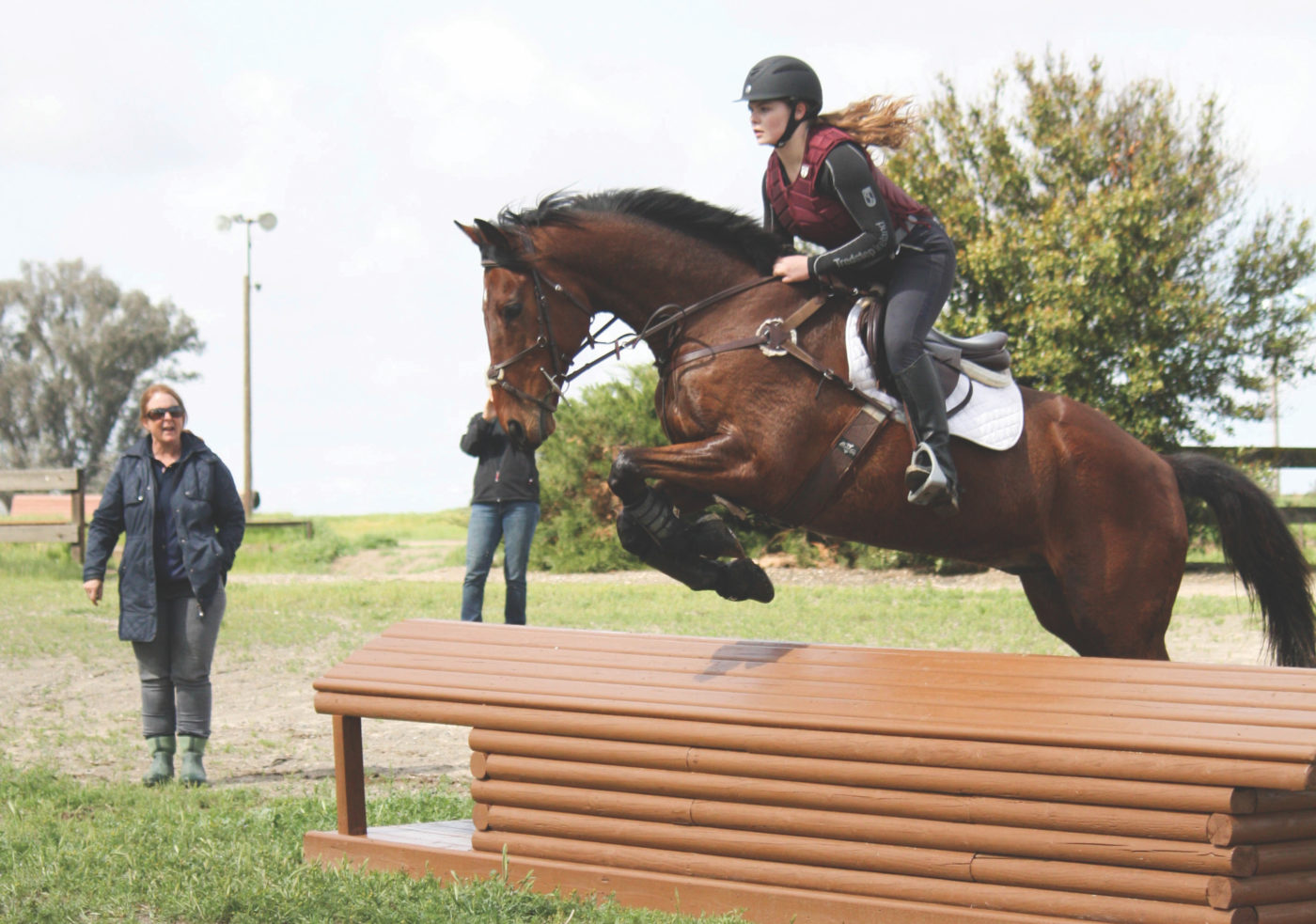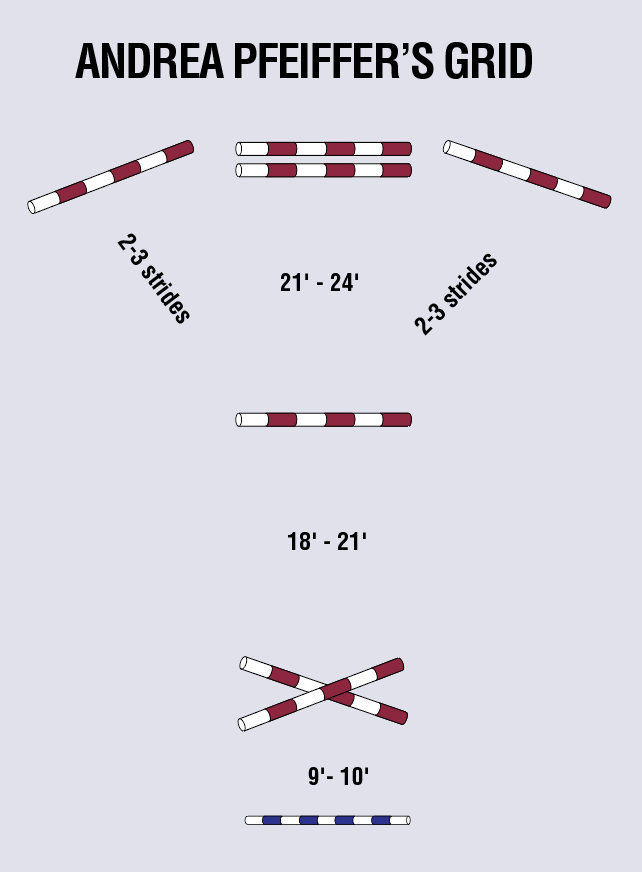Renew Your USEA Membership for the 2023 Season Today LEARN MORE

Ready to spice things up this winter training season? Do you want to use being stuck in the arena as an opportunity to fine tune your riding? In this series, we are revisiting some of our favorite Grid Pro Quo articles from Eventing USA to help you use the off-season to your advantage and keep you and your horse in tip-top shape for when it's time to get back out there. Click here to check out other past Grid Pro Quo exercises!
Like most professionals, I tend to do gridwork for most of the winter, before transitioning to coursework through the competition season. I find this exercise to be a good middle ground exercise as you have a little bit of a gymnastic combined with two easy bending exercises to set you up well for doing courses.
The entire purpose of this exercise is to teach your horse to keep a nice round shape over their fences. In order to do this, you need to set yourself up for success, which is why I’ve left the distances a little vague. When jumping related distances, I’m never afraid to change the distance slightly to ensure that the horse and rider are successful. This is especially true for the lower levels. And while I will expect more adjustability from the upper-level pairs, I firmly believe that you always have to be willing to adjust your exercise to ensure success.
Another great aspect of this exercise is that it teaches your horse patience. They learn to land, look, and listen for the rider to tell them where to go next. This means that riders are on task for giving their horse clear instructions on where to go next. I often find that riders get a little panicked anticipating where the take off point will be before the first jump. Again, in my effort to set everyone up for success, I will put a trot rail out in front of the first jump to relieve some of this anxiety.

Before you even think about jumping, you must have a good canter. End of story. Regardless of the level of the horse or rider, an enormous amount of my focus will be on the canter.
Oftentimes I will have my riders do a lot of transitions during their warm up, everything from transitions between gaits and within gaits, both while on the rail and while on circles. Another great warm up exercise is to transition between a two-point position and your full seat every three strides. This is a great exercise for teaching the rider how their balance affects their horse, and more importantly it teaches riders how to keep the same rhythm regardless of how they are sitting in the saddle.
The better the quality of the canter, the easier the jumps will come up, and riders start to learn that the distance will find them, not vice versa. It takes a long time for riders to really lock in on what that actually feels like, and this exercise is a good one to help them get there.
Once my riders are ready to start jumping, I will always start with the simple straight line gymnastic. The first jump will most always be a cross-rail, and I’m careful not to make it too big – 3' mark for the outside pole at most – while the remaining jumps will start off as rails on the ground. If the cross-rail gets too big, the remaining distances can get muddled. If at all possible, I like to set this up somewhere in the arena so that riders can approach it from both directions.
When the horse is confident and landing softly, I will put in the second vertical. And then I’ll typically add in an ascending oxer 21'-24' feet away. I purposely keep it simple, as the point for this straight line gymnastic is to simply give the rider a chance to practice their position, and for the horse to practice jumping in a good shape over a series of jumps.
When the riders are ready to move on, I will drop the vertical back to rails on the ground, and then add in the two angled fences as ground rails, which should be set 2-3 strides away (depending on the size and shape of your arena). The idea here is to get the horse and rider familiar with the idea of jumping and looking for their next jump.
Some horses will pick up on this right away, while other horses might need to be guided with an opening rein. If you do have to use an opening rein, you have to be careful that you don’t lose the outside shoulder. I want to see the entire horse turn, not just their head. So riders need to support their opening rein with their outside leg. The goal is to keep your horse pretty square between your aides. Once they are able to do this, I will make those angled fences into small jumps.
For more advanced pairs, little changes as you work through the exercise except the jumps will be slightly bigger. For these more advanced riders, I will keep the distances a little tighter to teach them how to jump from that deeper distance. And for the most advanced pair, I will bring one of the angled fences into a 21' distance to really promote a lot of bending and flexibility. This also really tests the relationship between the horse and rider, as the horse has to stay really tuned into their rider and where their rider is looking.
If the riders get through this super well, I will start making small courses for the riders to test their skills. Depending on what each pair needs to work on specifically, I will either keep the first trot rail in so that riders will always come back to the trot for that portion. Or I will take the trot rail away, adjust the distances as needed, and really test the riders on their ability to keep a quality canter throughout a short course.
Regardless of if you work through this entire exercise in one jump school, or you have to break it up into a few schooling sessions, the goal should always be to not over challenge your horse, but instead to set them up for success.
Based out of Chocolate Horse Farm in Petaluma, California, Pfeiffer has 25 years of experience training horses and riders to their highest potential. She is BHS certified and has made her mark both in the eventing and dressage world as both rider and trainer. Her students range from young riders to adult amateurs to working professionals, and have enjoyed success at all levels. To learn more about Pfeiffer, visit www.chocolatehorsefarm.net.